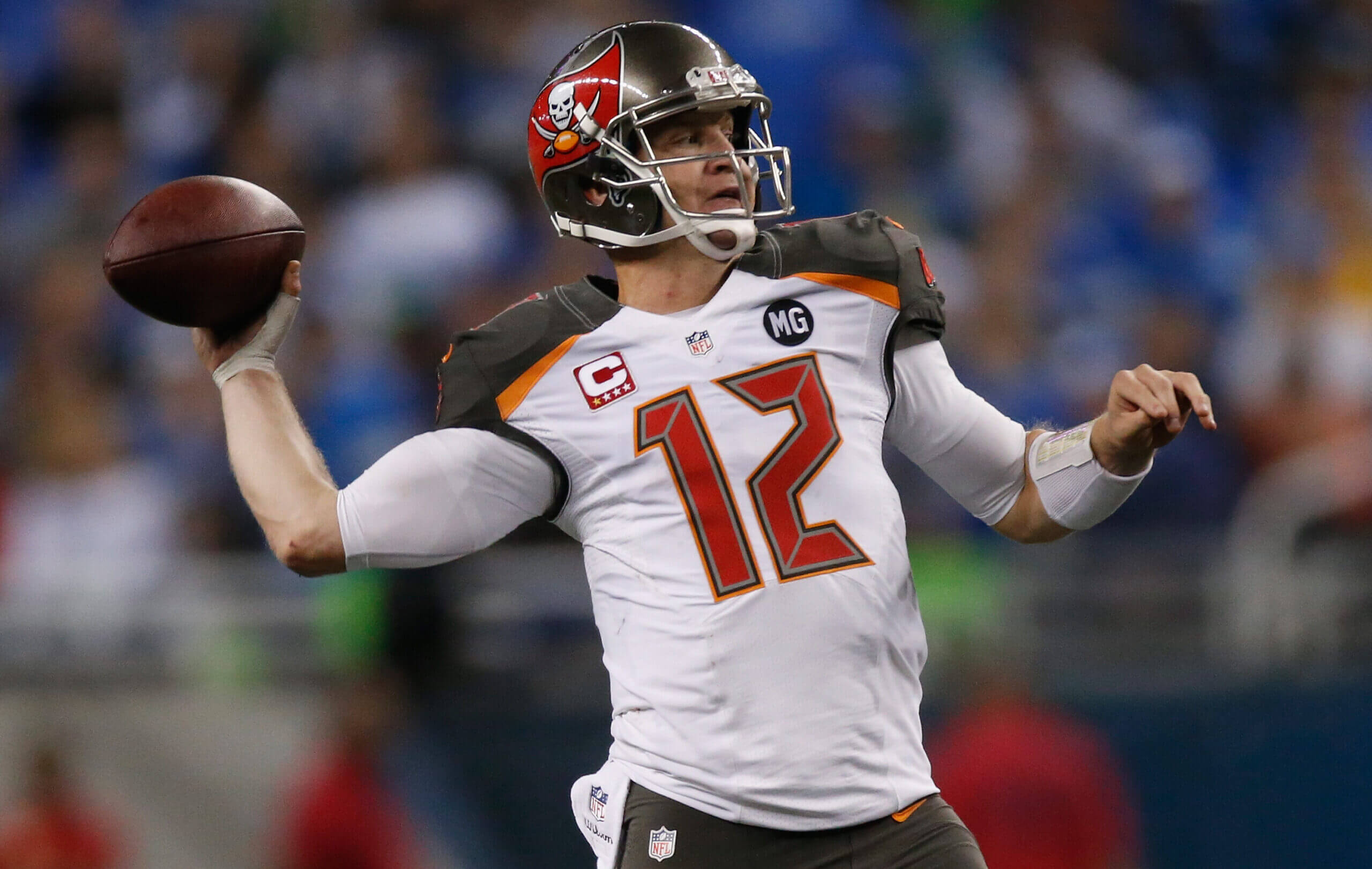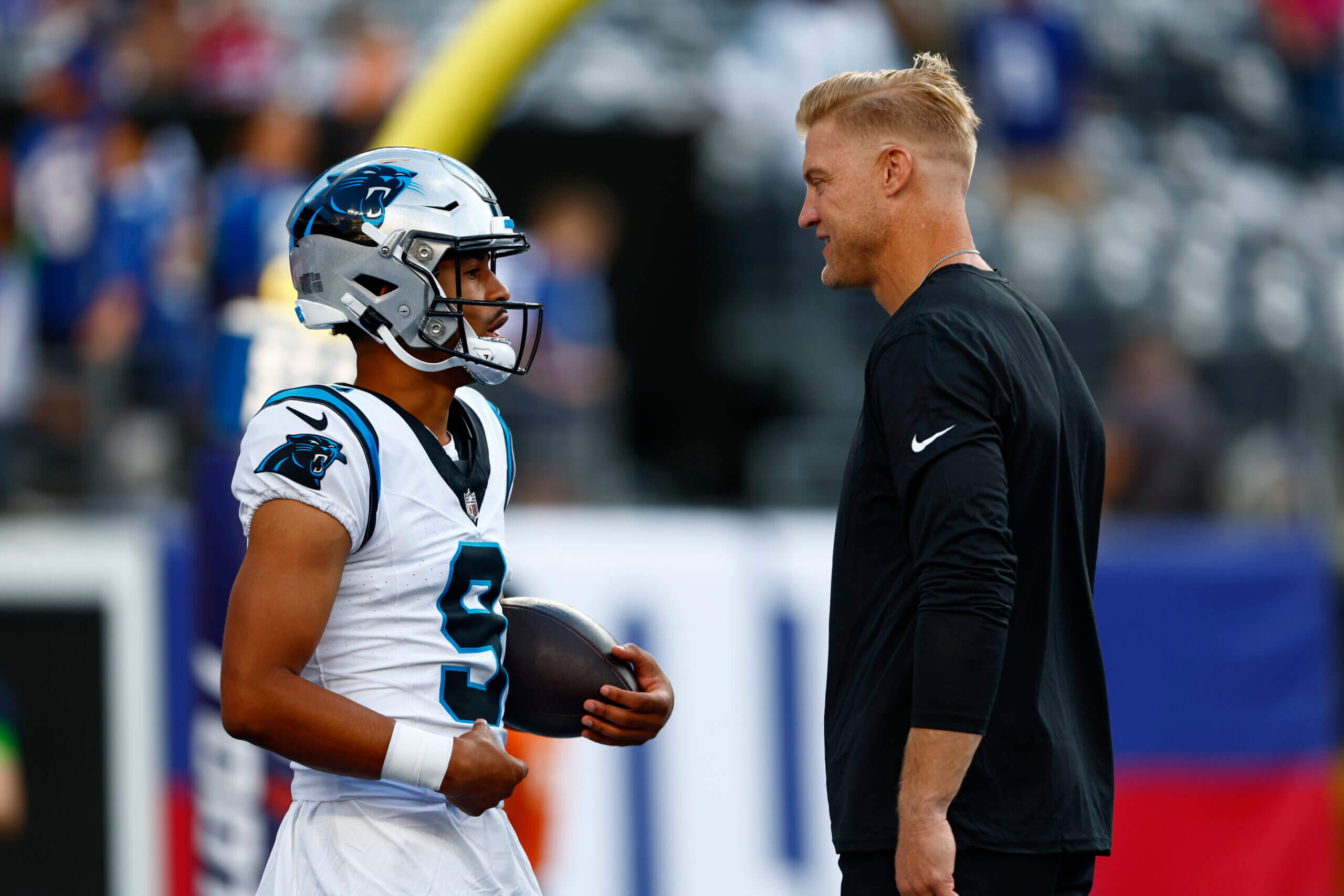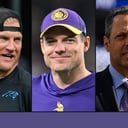
EAGAN, Minn. — Here is Josh McCown, the upbeat, backward-hat-wearing, gum-chewing Minnesota Vikings quarterbacks coach. Another preseason practice is complete, and the 45-year-old former NFL quarterback and journeyman is sitting outside the TCO Performance Center, baking in the heat and playing some trivia.
Can you name all 14 of your former offensive coordinators?
He laughs.
“Sounds like you could potentially be missing some,” he says.
Did I count ’em wrong?
“Well, we’ll go down the list,” he says. “Let’s just see.”
“Rich Olson. Jerry Sullivan. Alex Wood. Keith Rowen. Mike Martz. Greg Knapp. Jeff … was it Davidson? Yep, Davidson. After Jeff, let’s see, that was … Mike Martz again. That’s a repeat. Mike Tice.”
That’s one I didn’t have.
“He was in Chicago, yeah. Marc Trestman and Aaron Kromer. That’s 10. Jeff Tedford and (quarterbacks coach) Marcus Arroyo is 11. John DeFilippo is 12 in Cleveland. Then Hue Jackson and Pep Hamilton. Then John Morton. Then Jeremy Bates. Then Mike Groh in Philly. And then, technically, Tim Kelly in Houston. I didn’t play any snaps, but I was technically on the roster.”
So, like, 18 maybe?
“I guess, yeah,” McCown says.
That was impressive.
“Yeah. And then in college, going backward, was Jim Ferguson at Sam Houston, Larry Kueck at SMU, a guy named Greg Briner at SMU. High school was Wayne Coleman and Matt Turner. So …”
You’re just showing off. But how about this: If I asked you to translate offensive verbiage from one to the other, could you do it? Like, if I said “Mike Martz” and you rattle off a play.
“He was a digits legend. Like, Trips Right Scat Right 094 F-Seam Trail. That’s the play that (current Vikings quarterback) Sam Darnold hit in the opener of the preseason this year. It’s not the same call, but that’s our play in that verbiage.”
This is incredible.
Incredible recall, certainly, but also informative upon review. From the time the Vikings set their sights on drafting a quarterback this spring, they have acted intentionally in almost every regard. This includes McCown’s hiring, which surfaced randomly at the NFL Scouting Combine. Head coach Kevin O’Connell made the move for multiple reasons, one of which was a relationship between the two men that goes back more than a decade. Another factor, though, was exactly what McCown is doing here.
Using his memory. Translating information. Not taking himself too seriously or applying too much pressure. This is McCown the quarterbacks coach in a nutshell. Plucking away at what he’s provided for Darnold, J.J. McCarthy and the Vikings organization overall, it becomes more and more clear that the package is a carefully chosen amalgamation of attributes from the names he’s just mentioned.
It’s been a full-circle moment for Josh McCown and Sam Darnold as they reunite in Minnesota.
📺: https://t.co/iCm3Bs93L9 pic.twitter.com/q0WSvsqvwY
— Minnesota Vikings (@Vikings) June 12, 2024
Back to Trips Right Scat Right 094 F-Seam Trail.
This is Martz’s verbiage of the impressive throw Darnold made to wide receiver Jalen Nailor in the Vikings’ first preseason game, against the Las Vegas Raiders. Darnold released the ball before Nailor peeled off his route toward the middle of the field. McCown is still raving about it.
“The way Sam cut that ball loose, man,” McCown says, “it was just perfect.”
Like, the anticipation?
“One hundred percent,” McCown says, “and he’s learned that over time. We played together his rookie year. I probably talked about it then. I learned that from being coached by Martz and watching Jon Kitna and Kurt Warner do it. Cut the dang ball loose.”
Martz, for the uninitiated, was the St. Louis Rams’ head coach during the “Greatest Show on Turf” era. McCown first encountered him in 2006 when he was signed by the Detroit Lions at age 27. He’d been in the league for several seasons already and had started 20 games for the Arizona Cardinals after being a third-round pick in 2002. Yet when he showed up in Detroit, Martz described him as a “wild horse rider.”
Martz tells a story about a particular throw in McCown’s first practice with the Lions. Martz asked the quarterbacks to throw a deep in-cut over the middle of the field. McCown, noticing the safety floated down toward the in-cut, threw over the top on a deep post pattern instead. It went for a touchdown.
“I said, ‘What the f— was that?’” Martz recalls. “He looked at me and said, ‘What?’ I said, ‘What the f— was that? You kinda just do what you want to do?’ He didn’t understand.”
You could say Martz was simply being a hardass, but McCown acknowledges this was the first time he’d played in an intentional NFL passing game. He could not just catch the snap, take his drop and scan the field, looking for the open man. Martz’s offense dictated that he look in specific spots for different reasons — and throw the ball at the proper time.

Josh McCown spent time with 12 NFL franchises — and one UFL team — over 19 pro seasons. (Gregory Shamus / Getty Images)
Kitna, with whom McCown competed that season for the Lions’ starting job, assisted with the minutiae. The plays in Martz’s playbook were just a guide. On the field, other factors, like the speed of his receiver and the tendencies of the opposing defense, forced him to adapt. Think of learning an offensive system like an actor learning his lines: The script says one thing, but the actor’s flair is often what brings the production to life. Knowing what words to change or adaptations to make is a skill only developed through experience.
“It’s easy to just give a guy a play and say, ‘Find the open guy,’” McCown says. “And then you come in Monday morning as the coach and hold the clicker and go, ‘You probably should’ve thrown it to that dude.’ Well, yeah, right. Thank you.
“It’s harder work for the coach to go: ‘This is who we think is going to be open. This is where you’re going to start your eyes. And then react to that play, off of that, being as detailed as you can.’”
The challenge, of course, is balancing the details: the need to be purposeful with every aspect of your drop and eyes and decision-making, and the need to keep your mind quiet when you’re in the pocket and the crowd is yelling, the pass rushers are barreling in on you and the defense is swarming across the field.
If Martz, Kitna and Warner explained the need for specificity, Trestman focused on eliminating the gray area. Trestman simplified the amount and extent of McCown’s post-snap decision-making. More than at any other point in his career, McCown, who was 34 with the Chicago Bears in 2013, felt he knew where he was supposed to go with the football. And as long as he operated correctly, Trestman gave him affirmation on the back end — kind of like a catcher who shrugs when the pitcher throws the perfect pitch in the suggested spot and the hitter crushes it anyway. Right process, unfortunate result.
In O’Connell, McCown found someone who could relate to his experiences with other coaches. They met in 2015 in Cleveland. O’Connell was the Browns’ quarterbacks coach, and together they talked about their favorite concepts, verbiage and teaching philosophies. They worked with Johnny Manziel through that brutal 3-13 season. But McCown appreciated O’Connell’s approach and humility. The first-time NFL coach, six years younger than McCown, would seek advice from him.
They maintained contact after that season as O’Connell began to create a system of his own and McCown played for another five years before becoming the Carolina Panthers’ quarterbacks coach last year. McCown played in 102 NFL games and posted a 98:82 touchdown-to-interception ratio, but his experience with Bryce Young cemented something he says frequently about playing quarterback: This is freaking hard, man.
“In any span of three to five years, there’s maybe five to seven transcendent players at the position,” McCown says. “The rest of them need people around them.”
People, he says, referring mostly to talent on the field.
But the quarterbacks coach is important, too.

Josh McCown was the Carolina Panthers’ quarterbacks coach last season, working with No. 1 pick Bryce Young. (Rich Schultz / Getty Images)
O’Connell describes his teaching philosophy with quarterbacks by saying, “We want to tie the quarterback’s feet and eyes together.” In a general sense, this is the throughline between being detailed and not clouding the quarterback’s mind.
After naming all of his former offensive coordinators, McCown explains.
“When you watch a quarterback drop and you watch his helmet and it turns to the left, he’s looking left,” McCown says. “If you pause it, you’ll hopefully see the quarterback’s lower half and his feet start to move in that direction to then throw the ball. You’d be shocked, but so many guys — especially younger ones — they’re not connected. Their feet and eyes are all jacked up.”
So, you’re trying to get them synchronized?
“Exactly,” McCown says.
How do you teach that?
“Reps,” he replies, describing one of the drills the Vikings quarterbacks do daily. They receive the snap, glance over at a receiver on the right sideline, line up their body and throw. Then they catch another snap, shift their eyes to the left, line up their feet and throw again. Some days, they move from the right sideline to the left, as if they’re mimicking four progressions.
“You build that out until you get 22 people out there,” McCown says.

GO DEEPER
Vikings hoping they have team in place to successfully draft, develop rookie quarterback
Do you mean, like, adding the pass rush, which probably makes it harder to be as calm and disciplined with the feet and eyes?
“Now you’re getting it,” he says, “which takes us all the way back to Martz and to knowing exactly what you’re doing. If you aren’t confident on your end, then your own offense presses on your brain before you even start. Then it’s, ‘Uhhh, what do I? … Oh, no …’ If you know what you’re doing, if you can get guys to play in a system for years, it’s like: ‘Boom. There’s a ball. Boom. There’s another. Boom, boom, boom.’ You’re playing fast, processing. Stress hits, and they know the answer to the test.”
Experience is not required to learn all of this, but it does give him a distinctly empathetic viewpoint as a coach.
McCown encourages. He pats his quarterbacks on the helmet after good throws and offers criticism with a fist bump after bad ones. If he spots something wrong, he doesn’t allow much time to pass before mentioning what he saw. But he does not holler, scream or yell because it’s not authentic to him.
The position is hard enough, he says.

Free, daily NFL updates direct to your inbox.
Free, daily NFL updates direct to your inbox.
Sign Up
(Top photo: G. Newman Lowrance / Associated Press)